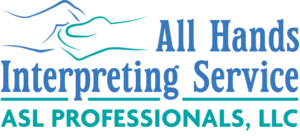Why use a professional interpreter?
Interpreting is a complex skill and requires ethical decision making and professional training, just like many other specialties such as law or medicine. Just because someone knows multiple languages, it does not mean they will be able to interpret effectively. Utilizing a non-professional can become a major liability and potentially harmful if the interpretation is not accurate.
How can I use an interpreter effectively?
Positioning: An interpreter should be opposite the deaf person and next to the person leading the discussion to allow the deaf person to have eye contact with both the interpreter and the speaker. The interpreter should also be in the client’s sightline of any visual, screen, or presentation.
Lighting: An ASL interpreter needs to be in visible lighting, but not in front of a bright light source such as a window or lamp.
I know some sign language. Should I use it?
If you know some sign language, it’s fine to great the deaf person to build rapport, and make a personal connection. Just remember, the interpreter is there so you can focus on what you’re bringing to the conversation and make sure everyone understands each other. If at any point, you don’t understand, don’t hesitate to ask for clarification.

